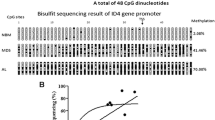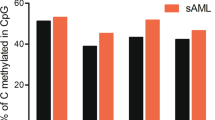Abstract
Hypermethylation of distal-less homeobox 4 (DLX4) has been increasingly identified in several cancers. Our study was aimed to determine the role of DLX4 methylation in regulating DLX4 expression and further analyze its clinical significance in de novo acute myeloid leukemia (AML) patients. DLX4 methylation level was detected by real-time quantitative methylation-specific PCR and bisulfite sequencing PCR. Treatment with 5-aza-2′-deoxycytidine (5-aza-dC) was used for demethylation studies. Clinical significance of DLX4 methylation was obtained by the comparison between the patients with and without DLX4 methylation. DLX4 was significantly methylated in AML patients compared with controls (P < 0.001). DLX4 methylation was negatively associated with DLX7 (the shorter DLX4 isoform) (R = −0.202, P = 0.021) but not BP1 (the longer DLX4 isoform) (R = −0.049, P = 0.582) expression in AML patients. DLX7 and BP1 messenger RNA (mRNA) were significantly increased after 5-aza-dC treatment in leukemic cell lines THP1 and Kasumi-1. DLX4 methylated patients showed significantly higher frequency of U2AF1 mutation compared with DLX4 unmethylated patients (P = 0.043). Both all AML and non-M3 patients with DLX4 methylation presented significantly lower complete remission rate than those with DLX4 unmethylation (P = 0.001 and <0.001, respectively). DLX4 methylated cases had significantly shorter overall survival than DLX4 unmethylated cases among both all AML (P = 0.003), non-M3 AML (P = 0.001), and cytogenetically normal AML (P = 0.032). Multivariate analysis confirmed that DLX4 methylation was independent risk factor in both all AML and non-M3 patients. Our study indicates that DLX4 hypermethylation is negatively associated with DLX7 expression and predicts poor clinical outcome in de novo AML patients.







Similar content being viewed by others
References
Estey E, Döhmer H. Acute myeloid leukaemia. Lancet. 2006;368:1894–907.
Lane SW, Scadden DT, Gilliland DG. The leukemic stem cell niche: current concepts and therapeutic opportunities. Blood. 2009;114:1150–7.
Avivi I, Rowe JM. Prognostic factors in acute myeloid leukemia. Curr Opin Hematol. 2005;12:62–7.
Marcucci G, Haferlach T, Döhner H. Molecular genetics of adult acute myeloid leukemia: prognostic and therapeutic implications. J Clin Oncol. 2011;29:475–86.
Marchesi F, Annibali O, Cerchiara E, Tirindelli MC, Avvisati G. Cytogenetic abnormalities in adult non-promyelocytic acute myeloid leukemia: a concise review. Crit Rev Oncol Hematol. 2011;80:331–46.
Grimwade D. The clinical significance of cytogenetic abnormalities in acute myeloid leukaemia. Best Pract Res Clin Haematol. 2001;14:497–529.
Byrd JC, Mrózek K, Dodge RK, Carroll AJ, Edwards CG, Arthur DC, et al. Pretreatment cytogenetic abnormalities are predictive of induction success, cumulative incidence of relapse, and overall survival in adult patients with de novo acute myeloid leukemia: results from Cancer and Leukemia Group B (CALGB 8461). Blood. 2002;100:4325–36.
Abate-Shen C. Deregulated homeobox gene expression in cancer: cause or consequence? Nat Rev Cancer. 2002;2:777–85.
Kraus P, Lufkin T. Dlx homeobox gene control of mammalian limb and craniofacial development. Am J Med Genet A. 2006;140:1366–74.
Mpollo MS, Beaudoin M, Berg PE, Beauchemin H, D’Agati V, Trudel M. BP1 is a negative modulator of definitive erythropoiesis. Nucleic Acids Res. 2006;34:5232–7.
Tomida S, Yanagisawa K, Koshikawa K, Yatabe Y, Mitsudomi T, Osada H, et al. Identification of a metastasis signature and the DLX4 homeobox protein as a regulator of metastasis by combined transcriptome approach. Oncogene. 2007;26:4600–8.
Trinh BQ, Barengo N, Naora H. Homeodomain protein DLX4 counteracts key transcriptional control mechanisms of the TGF-β cytostatic program and blocks the antiproliferative effect of TGF-β. Oncogene. 2011;30:2718–29.
Zhang L, Yang M, Gan L, He T, Xiao X, Stewart MD, et al. DLX4 upregulates TWIST and enhances tumor migration, invasion and metastasis. Int J Biol Sci. 2012;8:1178–87.
Sun Y, Lu X, Yin L, Zhao F, Feng Y. Inhibition of DLX4 promotes apoptosis in choriocarcinoma cell lines. Placenta. 2006;27:375–83.
Miyamoto K, Fukutomi T, Akashi-Tanaka S, Hasegawa T, Asahara T, Sugimura T, et al. Identification of 20 genes aberrantly methylated in human breast cancers. Int J Cancer. 2005;116:407–14.
Tong WG, Wierda WG, Lin E, Kuang SQ, Bekele BN, Estrov Z, et al. Genome-wide DNA methylation profiling of chronic lymphocytic leukemia allows identification of epigenetically repressed molecular pathways with clinical impact. Epigenetics. 2010;5:499–508.
Rauch TA, Wang Z, Wu X, Kernstine KH, Riggs AD, Pfeifer GP. DNA methylation biomarkers for lung cancer. Tumor Biol. 2012;33:287–96.
Sakane J, Taniyama K, Miyamoto K, Saito A, Kuraoka K, Nishimura T, et al. Aberrant DNA methylation of DLX4 and SIM1 is a predictive marker for disease progression of uterine cervical low-grade squamous intraepithelial lesion. Diagn Cytopathol. 2015;43:462–70.
Harada H, Miyamoto K, Yamashita Y, Taniyama K, Ohdan H, Okada M. Methylated DLX4 predicts response to pathologic stage I non-small cell lung cancer resection. Ann Thorac Surg. 2015;99:1746–54.
Swerdlow SH, Campo E, Harris NL, Jaffe ES, Pileri SA, Stein H, et al. WHO classification of tumours of haematopoietic and lymphoid tissues. Lyon: IARC Press; 2008.
Bennett JM, Catovsky D, Daniel MT, Flandrin G, Galton DA, Gralnick HR, et al. Proposed revised criteria for the classification of acute myeloid leukaemia. A report of the French-American-British Cooperative Group. Ann Intern Med. 1985;103:620–5.
Grimwade D, Hills RK, Moorman AV, Walker H, Chatters S, Goldstone AH, et al. Refinement of cytogenetic classification in acute myeloid leukemia: determination of prognostic significance of rare recurring chromosomal abnormalities among 5876 younger adult patients treated in the United Kingdom Medical Research Council trials. Blood. 2010;116:354–65.
Li Y, Lin J, Yang J, Qian J, Qian W, Yao DM, et al. Overexpressed let-7a-3 is associated with poor outcome in acute myeloid leukemia. Leuk Res. 2013;37:1642–7.
Zhou JD, Yang L, Zhang YY, Yang J, Wen XM, Guo H, et al. Overexpression of BAALC: clinical significance in Chinese de novo acute myeloid leukemia. Med Oncol. 2015;32:386.
Lin J, Yao DM, Qian J, Chen Q, Qian W, Li Y, et al. Recurrent DNMT3A R882 mutations in Chinese patients with acute myeloid leukemia and myelodysplastic syndrome. PLoS One. 2011;6:e26906.
Lin J, Yao DM, Qian J, Chen Q, Qian W, Li Y, et al. IDH1 and IDH2 mutation analysis in Chinese patients with acute myeloid leukemia and myelodysplastic syndrome. Ann Hematol. 2012;91:519–25.
Yang X, Qian J, Sun A, Lin J, Xiao G, Yin J, et al. RAS mutation analysis in a large cohort of Chinese patients with acute myeloid leukemia. Clin Biochem. 2013;46:579–83.
Qian J, Yao DM, Lin J, Qian W, Wang CZ, Chai HY, et al. U2AF1 mutations in Chinese patients with acute myeloid leukemia and myelodysplastic syndrome. PLoS One. 2012;7:e45760.
Wen XM, Lin J, Yang J, Yao DM, Deng ZQ, Tang CY, et al. Double CEBPA mutations are prognostically favorable in non-M3 acute myeloid leukemia patients with wild-type NPM1 and FLT3-ITD. Int J Clin Exp Pathol. 2014;7:6832–40.
Zhou JD, Wang YX, Zhang TJ, Yang DQ, Yao DM, Guo H, et al. Epigenetic inactivation of DLX4 is associated with disease progression in chronic myeloid leukemia. Biochem Biophys Res Commun. 2015;463:1250–6.
Zhang TJ, Zhou JD, Yang DQ, Wang YX, Yao DM, Ma JC, et al. Hypermethylation of DLX4 predicts poor clinical outcome in patients with myelodysplastic syndrome. Clin Chem Lab Med. 2015.
Oki Y, Issa JP. Epigenetic mechanisms in AML—a target for therapy. Cancer Treat Res. 2010;145:19–40.
Shaknovich R. Gene expression and epigenetic deregulation. Adv Exp Med Biol. 2013;792:133–50.
Gao Y, Li Z, Guo X, Liu Y, Zhang K. DLX4 as a prognostic marker for hepatocellular carcinoma. Neoplasma. 2014;61:318–23.
Yu M, Wan YF, Zou QH. Prognostic significance of BP1 mRNA expression level in patients with non-small cell lung cancer. Clin Biochem. 2008;41:824–30.
Yu M, Yang Y, Shi Y, Wang D, Wei X, Zhang N, et al. Expression level of beta protein 1 mRNA in Chinese breast cancer patients: a potential molecular marker for poor prognosis. Cancer Sci. 2008;99:173–8.
Haga SB, Fu S, Karp JE, Ross DD, Williams DM, Hankins WD, et al. BP1, a new homeobox gene, is frequently expressed in acute leukemias. Leukemia. 2000;14:1867–75.
Zhou JD, Yang J, Guo H, Deng ZQ, Wen XM, Yang L, et al. BP1 overexpression is associated with adverse prognosis in de novo acute myeloid leukemia. Leuk Lymphoma. 2015:1–19.
Xie XH, Xu XP, Sun CY, Yu ZJ. Regulation of the oncogenic function of distal-less 4 by microRNA-122 in hepatocellular carcinoma. Mol Med Rep. 2015;12:1375–80.
Woods BA, Levine RL. The role of mutations in epigenetic regulators in myeloid malignancies. Immunol Rev. 2015;263:22–35.
Shih AH, Abdel-Wahab O, Patel JP, Levine RL. The role of mutations in epigenetic regulators in myeloid malignancies. Nat Rev Cancer. 2012;12:599–612.
Ilagan JO, Ramakrishnan A, Hayes B, Murphy ME, Zebari AS, Bradley P, et al. U2AF1 mutations alter splice site recognition in hematological malignancies. Genome Res. 2015;25:14–26.
Acknowledgments
This study was supported by National Natural Science Foundation of China (81270630, 81172592), Science and Technology Special Project in Clinical Medicine of Jiangsu Province (BL2012056), 333 Project of Jiangsu Province (BRA2013136), Science and Technology Infrastructure Program of Zhenjiang (SS2012003), and Medical Key Talent Project of Zhenjiang, Social Development Foundation of Zhenjiang (SH2013042, SH2013082, SH2014044, SH2014086).
Author information
Authors and Affiliations
Corresponding authors
Ethics declarations
Conflicts of interest
None.
Additional information
Jing-dong Zhou and Ting-juan Zhang contributed equally to this work.
Rights and permissions
About this article
Cite this article
Zhou, Jd., Zhang, Tj., Wang, Yx. et al. DLX4 hypermethylation is a prognostically adverse indicator in de novo acute myeloid leukemia. Tumor Biol. 37, 8951–8960 (2016). https://doi.org/10.1007/s13277-015-4364-4
Received:
Accepted:
Published:
Issue Date:
DOI: https://doi.org/10.1007/s13277-015-4364-4




